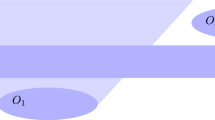Abstract
As a consequence of its dynamical motion a quantum mechanical system may be considered as a quantum mechanical clock. If one demands that the time be an observable which corresponds to a hypermaximal time operator in Hilbert space, then, for systems having a continuous energy spectrum with a lower limit, in the framework of the nonrelativistic theory to be discussed here there must exist an upper limit of energy, too. Furthermore the time operator is not defined on the whole Hilbert space, but only on state functions satisfying a certain condition. Therefrom it results that a quantum mechanical clock of this kind can be read off only in a sequence of equidistant times separated by a “minimal time”. The beginning of the time measurement being arbitrary the scale of time may be shifted according to the homogenity in time.
Especially for a free particle beside the minimal time also a minimal length is obtained. The equidistant scale in space is not absolute either, but permits an arbitrary choice of the point of reference according to homogenity in space. The modificated spreading of the probability distribution of particle position is discussed.
Similar content being viewed by others
Author information
Authors and Affiliations
Additional information
Herrn Dr. A.Schönhofer sind wir für wertvolle Hinweise zu Dank verpflichtet. Herrn Prof. Dr.Grossmann danken wir für sein in Diskussionen gezeigtes Interesse.
Rights and permissions
About this article
Cite this article
Fick, E., Engelmann, F. Quantentheorie der Zeitmessung. Z. Physik 175, 271–282 (1963). https://doi.org/10.1007/BF01375105
Received:
Issue Date:
DOI: https://doi.org/10.1007/BF01375105




